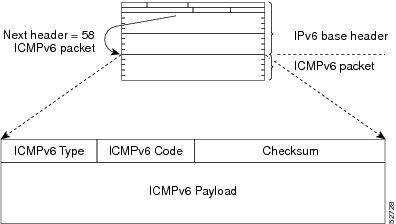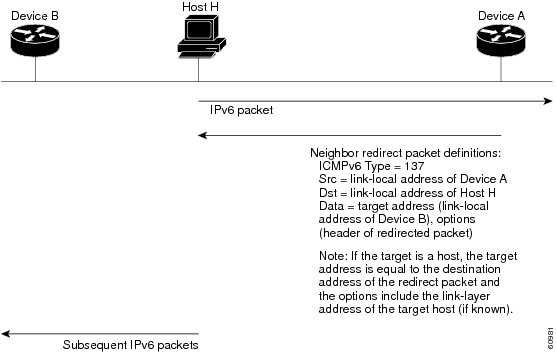- Read Me First
- IPv6 Addressing and Basic Connectivity
- IPv6 Anycast Address
- IPv6 Switching: Cisco Express Forwarding Support
- Unicast Reverse Path Forwarding for IPv6
- IPv6 Services: AAAA DNS Lookups over an IPv4 Transport
- IPv6 MTU Path Discovery
- ICMP for IPv6
- IPv6 ICMP Rate Limiting
- ICMP for IPv6 Redirect
- IPv6 Neighbor Discovery
- IPv6 Neighbor Discovery Cache
- IPv6 Default Router Preference
- IPv6 Stateless Autoconfiguration
- IPv6 RFCs
ICMP for IPv6 Redirect
The IPv6 Redirect Messages feature enables a device to send Internet Control Message Protocol (ICMP) IPv6 neighbor redirect messages to inform hosts of better first-hop nodes (devices or hosts) on the path to a destination.
- Finding Feature Information
- Information About ICMP for IPv6 Redirect
- How to Display IPv6 Redirect Messages
- Configuration Examples for ICMP for IPv6 Redirect
- Additional References
- Feature Information for ICMP for IPv6 Redirect
Finding Feature Information
Your software release may not support all the features documented in this module. For the latest caveats and feature information, see Bug Search Tool and the release notes for your platform and software release. To find information about the features documented in this module, and to see a list of the releases in which each feature is supported, see the feature information table.
Use Cisco Feature Navigator to find information about platform support and Cisco software image support. To access Cisco Feature Navigator, go to www.cisco.com/go/cfn. An account on Cisco.com is not required.
Information About ICMP for IPv6 Redirect
ICMP for IPv6
Internet Control Message Protocol (ICMP) in IPv6 functions the same as ICMP in IPv4. ICMP generates error messages, such as ICMP destination unreachable messages, and informational messages, such as ICMP echo request and reply messages. Additionally, ICMP packets in IPv6 are used in the IPv6 neighbor discovery process, path MTU discovery, and the Multicast Listener Discovery (MLD) protocol for IPv6. MLD is used by IPv6 devices to discover multicast listeners (nodes that want to receive multicast packets destined for specific multicast addresses) on directly attached links. MLD is based on version 2 of the Internet Group Management Protocol (IGMP) for IPv4.
A value of 58 in the Next Header field of the basic IPv6 packet header identifies an IPv6 ICMP packet. ICMP packets in IPv6 are like a transport-layer packet in the sense that the ICMP packet follows all the extension headers and is the last piece of information in the IPv6 packet. Within IPv6 ICMP packets, the ICMPv6 Type and ICMPv6 Code fields identify IPv6 ICMP packet specifics, such as the ICMP message type. The value in the Checksum field is derived (computed by the sender and checked by the receiver) from the fields in the IPv6 ICMP packet and the IPv6 pseudoheader. The ICMPv6 Data field contains error or diagnostic information relevant to IP packet processing. The figure below shows the IPv6 ICMP packet header format.

IPv6 Neighbor Redirect Message
A value of 137 in the type field of the ICMP packet header identifies an IPv6 neighbor redirect message. Devices send neighbor redirect messages to inform hosts of better first-hop nodes on the path to a destination (see the figure below).

 Note | A device must be able to determine the link-local address for each of its neighboring devices in order to ensure that the target address (the final destination) in a redirect message identifies the neighbor device by its link-local address. For static routing, the address of the next-hop device should be specified using the link-local address of the device; for dynamic routing, all IPv6 routing protocols must exchange the link-local addresses of neighboring devices. |
After forwarding a packet, a device should send a redirect message to the source of the packet under the following circumstances:
The destination address of the packet is not a multicast address.
The packet was not addressed to the device.
The packet is about to be sent out the interface on which it was received.
The device determines that a better first-hop node for the packet resides on the same link as the source of the packet.
The source address of the packet is a global IPv6 address of a neighbor on the same link, or a link-local address.
Use the ipv6 icmp error-interval command to limit the rate at which the device generates all IPv6 ICMP error messages, including neighbor redirect messages, which ultimately reduces link-layer congestion.
 Note | A device must not update its routing tables after receiving a neighbor redirect message, and hosts must not originate neighbor redirect messages. |
How to Display IPv6 Redirect Messages
Displaying IPv6 Redirect Messages
1.
enable
2.
show
ipv6
interface
[brief] [type
number] [prefix]
3.
show
ipv6
route
[ipv6-address |
ipv6-prefix/prefix-length |
protocol |
interface-type
interface-number]
4.
show
ipv6
traffic
5.
show
hosts
[vrf
vrf-name |
all |
hostname |
summary]
6.
enable
7.
show
running-config
DETAILED STEPS
Configuration Examples for ICMP for IPv6 Redirect
Example: Displaying IPv6 Interface Statistics
In the following example, the show ipv6 interface command is used to verify that IPv6 addresses are configured correctly for GigabitEthernet interface 0/0/0. Information is also displayed about the status of IPv6 neighbor redirect messages, IPv6 neighbor discovery messages, and stateless autoconfiguration.
Device# show ipv6 interface gigabitethernet 0/0/0
GigabitEthernet0/0/0 is up, line protocol is up
IPv6 is stalled, link-local address is FE80::1
Global unicast address(es):
2001:DB8:2000::1, subnet is 2001:DB8:2000::/64
2001:DB8:3000::1, subnet is 2001:DB8:3000::/64
Joined group address(es):
FF02::1
FF02::2
FF02::1:FF00:1
MTU is 1500 bytes
ICMP error messages limited to one every 100 milliseconds
ICMP redirects are enabled
ND DAD is enabled, number of DAD attempts: 1
ND reachable time is 30000 milliseconds
ND advertised reachable time is 0 milliseconds
ND advertised retransmit interval is 0 milliseconds
ND router advertisements are sent every 200 seconds
ND router advertisements live for 1800 seconds
Hosts use stateless autoconfig for addresses.
Additional References
Related Documents
Related Topic |
Document Title |
|---|---|
|
IPv6 addressing and connectivity |
IPv6 Configuration Guide |
|
Cisco IOS commands |
|
|
IPv6 commands |
Cisco IOS IPv6 Command Reference |
|
Cisco IOS IPv6 features |
Standards and RFCs
Standard/RFC |
Title |
|---|---|
|
RFCs for IPv6 |
IPv6 RFCs |
MIBs
|
MIB |
MIBs Link |
|---|---|
|
|
To locate and download MIBs for selected platforms, Cisco IOS releases, and feature sets, use Cisco MIB Locator found at the following URL: |
Technical Assistance
Description |
Link |
|---|---|
|
The Cisco Support and Documentation website provides online resources to download documentation, software, and tools. Use these resources to install and configure the software and to troubleshoot and resolve technical issues with Cisco products and technologies. Access to most tools on the Cisco Support and Documentation website requires a Cisco.com user ID and password. |
Feature Information for ICMP for IPv6 Redirect
The following table provides release information about the feature or features described in this module. This table lists only the software release that introduced support for a given feature in a given software release train. Unless noted otherwise, subsequent releases of that software release train also support that feature.
Use Cisco Feature Navigator to find information about platform support and Cisco software image support. To access Cisco Feature Navigator, go to www.cisco.com/go/cfn. An account on Cisco.com is not required.Feature Name |
Releases |
Feature Information |
|---|---|---|
|
IPv6: ICMPv6 Redirect |
12.0(22)S 12.2(4)T 12.2(14)S 12.2(17a)SX1 12.2(25)SG 12.2(28)SB 12.2(33)SRA 15.3(1)S Cisco IOS XE Release 2.1 |
The IPv6 Redirect Messages feature enables a device to send ICMP IPv6 neighbor redirect messages to inform hosts of better first-hop nodes on the path to a destination. The following commands were introduced or modified: show ipv6 interface, show ipv6 neighbors, show ipv6 route, show ipv6 traffic. |
 Feedback
Feedback